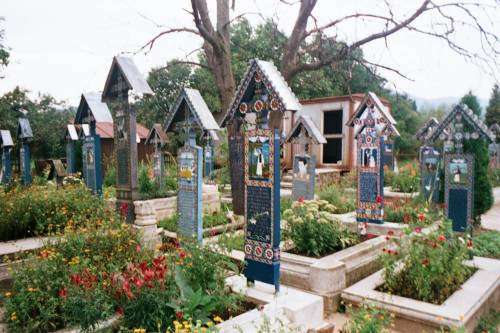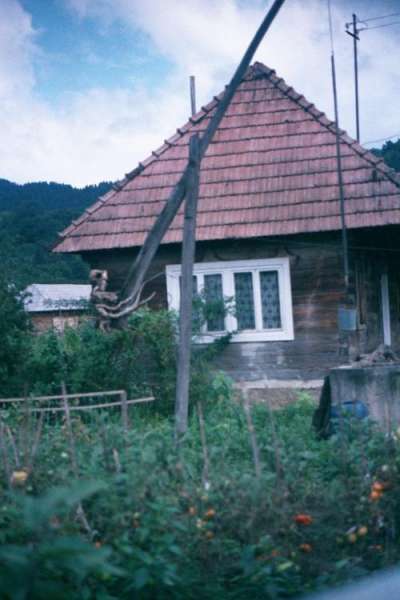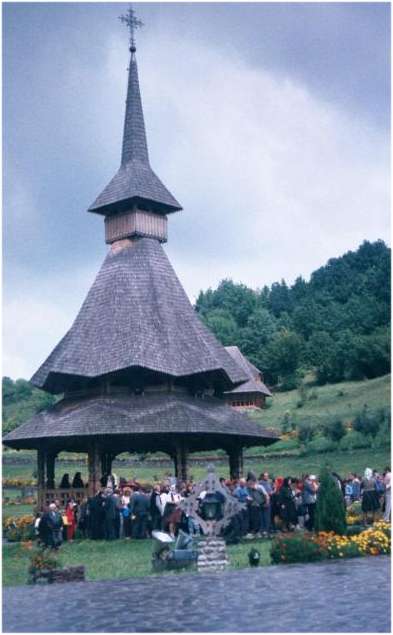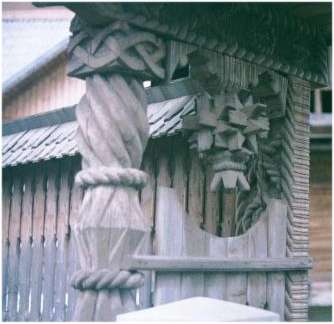
At the conclusion of the International Puzzle Party in Belgium, Dick and Kate Jones had a delightful visit August 11 and 12, 2002, in Novi Sad, Yugoslavia, with Zdravko Zivkovic, and then took a night train to Budapest to meet up with the tour group of twenty other IPP participants, organized by John Rausch, headed for a week in Romania.
A very comfortable chartered bus and a very personable and knowledgeable tour guide, Dan (pronounced "Don") Comanescu, conveyed us through the villages and towns of Maramures (pronounced "Mahrahmooresh"), a mountainous province of Romania virtually untouched and unspoiled by the world's progress of the last four centuries.
Kate's knowledge of Hungarian came in handy a couple of times. Many Romanians, especially near the border with Hungary, are of Hungarian descent or at least speak the language.
The well-planned itinerary included hikes through villages, rides in horse-drawn carts, treks through high meadows, watching a sheep-milking, a picnic under the trees, a drive through Transylvania, and a three-day stay at a farmhouse in Hoteni that had been remodeled into a comfortable lodge.

Hiking through haystack-dotted meadows, Kate in camouflage pants

Four sheep milkers and, behind them, the herd to be processed. The sheep are in their summer grazing grounds in the high meadows.
Our host and owner of the farm lodge, Mr. Popp, is also a famous musician and entertained us with Romanian and Hungarian folk music. Vigorous virtuoso violin playing was reminiscent of gypsy music, although gypsies are not generally well thought of in these parts. A high point of one evening was when maestro Popp danced a spirited csardas with Kate. "Popp," by the way, is a prevalent family name in the area. About half the tombstones in cemeteries we visited bore that name.

The "Merry Cemetery" in Sighet has humorous grave markers carved and painted with cartoons and a poem about the occupant's profession or specialty, or even mode of demise.
Mainly agrarian, the people enjoy a self-sufficient life close to the earth, with vast and fertile fields of crops and orchards, and with oxen, horses, sheep and poultry living in close proximity to their homes. Almost everything is built of wood, a plentiful resource of the region. Each farmhouse has its own well and an ornate wood gate.

Long pole and counterweight help haul water from well.

Kate admires carvings that ornament a gateway.
The inhabitants, especially the women, are frequently seen in colorful native garb. Electric wires are everywhere, as are gas tanks for cookstoves and heating. So behind the facade of rural innocence there is an infrastructure of modern energy supplies. A satellite dish here and there hints at the presence of some TV and even Internet access.
A major focus of village life are the churches, built of wood and lavishly decorated with paintings of holy icons and with carvings along every beam. We visited many such churches, some of great antiquity, as well as a very modern cathedral being newly dedicated on the day of our visit (see picture below). The ancient wood churches of Maramures are among the 730 greatest marvels of the world.

Outdoor religious service on day of the Assumption at a monastery in Barsana.

New juxtaposed with an old wooden church. Note roofed fence in foreground.

Day of dedication, a grand celebration in Brasov.
Because of the high humidity and abundant rain fall, the wood roofs have to be protected with tin or other metal shieldings. Even the fences have little metal roofings to keep the wood from rotting. See picture above.
The prevailing religion of the region is Eastern Orthodox. Crucifixes carved in wood adorn many street corners. The long Communist occupation and its practice of collectivization and atheism appear to have had little or no effect in this province.
The puzzle collectors in the group were especially captivated by a woodcraft style that closely resembles a burr puzzle, with several pieces of wood — notched sticks or rods — interlocked to form a knot or ball. These occurred in many sizes, from tiny ones attached to sticks the size of a wooden spoon that might have been tools for carding wool, to huge ones that stood like pillars or hung from gates (see picture below). The collectors purchased many of these items as souvenirs.

Gigantic burr-like structure decorates this gate.
And oh, the food! Our tour guide had arranged for three great meals a day, skillfully weaving in sightseeing adventures between meals. Fresh-baked bread and rolls, cheeses and lunchmeats and jams for breakfast, with fresh fruit, milk, juices and tonic or mineral water, were served whether we stayed at a 5-star hotel or a simple farm house dormitory.
Plain tap water was almost unheard-of and had to be requested specially. "Water" meant either flat or carbonated mineral water served in bottles. Our tour guide took much trouble to supply the bus with cases of bottled regular water. In fact, he was altogether heroic in seeing to our varied needs and desires.
Lunches and dinners were always a culinary treat as five or six courses made their way past our hungry mouths and eyes. Superlative soups, salads, egplant dip, meats, tasty vegetables and delirious desserts became a daily ritual we easily became accustomed to. And the native alcoholic beverage, a clear, water-like and fire-tasting fluid pronounced "tswika" (spelling optional), a plum brandy, was consumed in generous quantities. Its special virtue — no hangover!
Our nostrils also got a good workout, from the irresistible food smells to the aroma of barnyards, the fresh scent of mown hay stacked in dome-like piles, the traffic fumes, the bodies innocent of soap, the ubiquitous cigarette smoke, the clear mountain air in the dewy mornings.
One farmhouse we visited in Sarbi had a large waterwheel, ingeniously constructed to flow water through a basin for washing rugs and blankets. They also had a still for making the famous tsuika brandy. Such visits by tourists appeared to be part of their routine and livelihood. See their house below.
